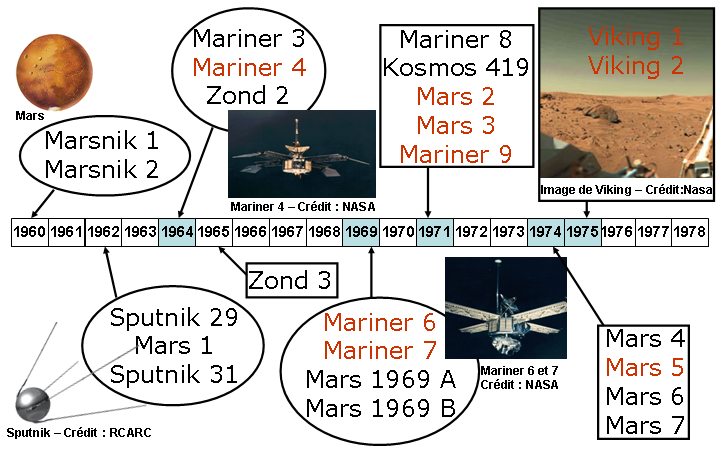The Mars missions
The Mars missions started in 1960 with the launch of two Russian orbiters : Marsnick 1 and Marsnick 2. These missions were unfortunately unsuccessful. The United States followed in 1964 with the launch of Mariner 4, which transmitted the first images of Mars. From that time, the Soviet and the U.S. have succeeded in implementing many projects to study the planet. If there were a lot of failures, other missions have been a great success. The first maps of Mars, for example, were made by the Mariner 9 mission (launch in 1971) who discovered giant volcanoes and valleys evoking riverbeds. Hence the question: "Is there water on Mars ?". In 1975, Viking 1 and Viking 2 were launched by the United States and toke pictures. Mars Pathfinder (1996) was another great success. This 259 kg spacecraft carried a small automatic car, "Sojourner", which analyzed and photographed the Martian soil near the landing site. The same year, the orbiter Mars Global Surveyor (MGS) was launched. It gave us a lot of information until 2006 (years during which we lost contact), established a mapping of Mars and questioned the non-existence of liquid water on Mars. Mars Odyssey (ââ¬ÅODYââ¬Â, launched in 2001) and Mars Reconnaissance Orbiter ("MRO", launched in 2005) also provided a lot of data which are still being analyzed. The first European probe, Mars Express is in orbit around Mars since December 25 2003, and the mission is very successful. Mars Express has revealed many sites containing salt and clay that could not exist without the presence of liquid water in the past. This reinforces the assumption that in the past, Mars was wetter and possibly warmer than today. In 2003, NASA's exploration rovers Spirit and Opportunity have shown that that Mars used to be wet. This mission has convinced the scientific community's interest to have a mobile component in future missions.
In 2018, ExoMars will explore the red planet, looking for signs of life (past or present). It will be the first mission to combine the mobility of a Rover and sampling the sub-surface of Mars. The contribution of these missions is of great importance to improve our knowledge of the red planet and more generally the solar system.
|
The missions in red are those that have been successful.
|
 |
|
